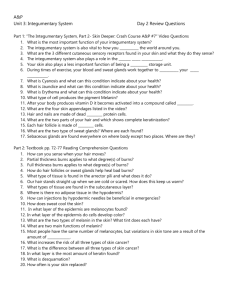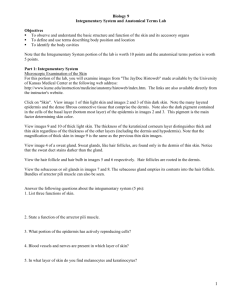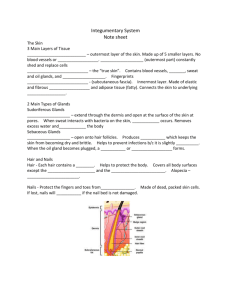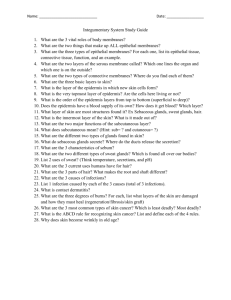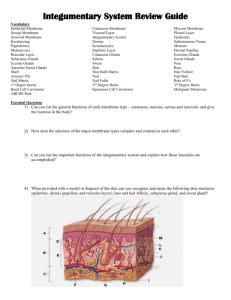The Integumentary System
advertisement
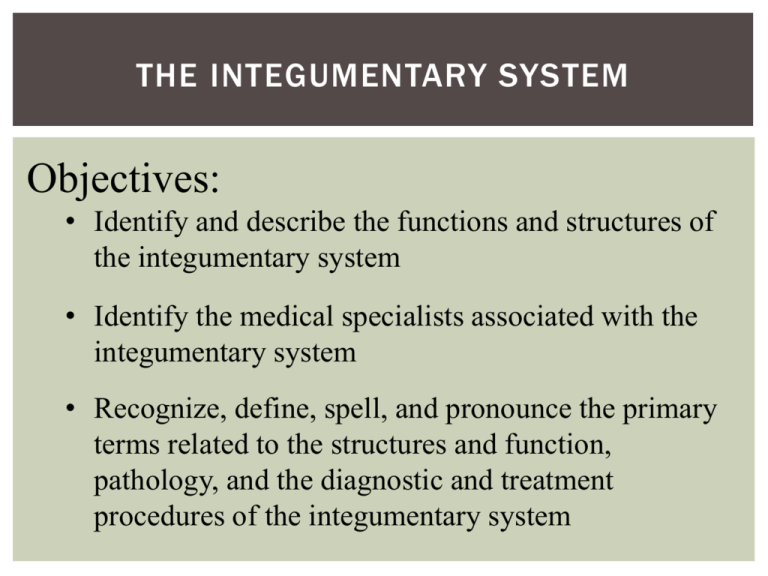
THE INTEGUMENTARY SYSTEM Objectives: • Identify and describe the functions and structures of the integumentary system • Identify the medical specialists associated with the integumentary system • Recognize, define, spell, and pronounce the primary terms related to the structures and function, pathology, and the diagnostic and treatment procedures of the integumentary system THE INTEGUMENTARY SYSTEM •Made up of the skin and its related structures -the sebaceous glands -the sweat glands -hair -nails THE INTEGUMENTARY SYSTEM: FUNCTIONS Skin: • Waterproofs the body and prevents fluid loss • Blocks the entrance of pathogens into the body • Major receptor for the sense of touch • Helps the body manufacture vitamin D from the sun’s ultraviolet light • Provides insulation and protection for underlying structures THE INTEGUMENTARY SYSTEM: FUNCTIONS Sebaceous glands: • Secretes sebum (oil) that lubricates the skin and discourages growth of bacteria Sweat glands: • Help regulate body temperature and water content by secreting sweat. • Eliminates small amounts of metabolic waste THE INTEGUMENTARY SYSTEM: FUNCTIONS Hair: • Helps control the loss of body heat Nails: • Protects the dorsal surface of the last bone of each toe and fingernail • Also helpful in opening pop cans! THE SKIN Made up of 3 basic layers 1. The epidermis 2. The dermis 3. The subcutaneous layer THE EPIDERMIS The outermost layer of the skin, made up of several specialized epithelial tissues •Squamous Epithelial Tissue – forms the upper layer of the epidermis. Flat, scaly cells that are continuously shed •Basal Layer – the lowest layer of the epidermis. Cells are produced and pushed upward to the surface where they die and become filled with keratin •Keratin- a fibrous water-repellent protein and a primary component of the epidermis •Melanocytes – cells found in the basal cell layer, that produce and contain a dark brown to black pigment called melanin •Melanin – pigment that determines the color of the skin. Also helps protect against some of the harmful effects of Ultraviolet light THE DERMIS • The thick layer of living tissue directly below the epidermis • Contains connective tissue, blood and lymph vessels, nerve fibers and sensory nerve endings that detect touch, temp. pain, and pressure • Also contains the hair follicles and the sebaceous and sweat glands TISSUES WITHIN THE DERMIS •Collagen – a tough yet flexible fibrous protein material found in the skin, bones, cartilage, tendons and ligaments •Mast cells – found in the connective tissue of the dermis. They respond to injury, infection, or allergy by producing and releasing substances including heparin and histamine •Heparin – released in response to an injury, is an anticoagulent (prevents clotting) Why would we want our bodies to prevent clotting at an injury site? •Histamine – released in response to allergens, causes the signs of an allergic response, including itching and increased mucus secretion. THE SUBCUTANEOUS LAYER • Located just below the skin, connects the skin to the surface muscles • Made up of loose connective tissue and adipose tissue • Lipocytes are predominant in the subcutaneous layer where they manufacture and store large quantities of fat Considering the subcutaneous layer’s primary component, what protective functions does this layer serve? THE SEBACEOUS GLANDS • Located in the dermis layer of the skin and are closely associated with hair follicles • Secretes sebum through ducts opening into the hair follicles where it moves onto the surface and lubricates the skin and prevents drying out • Sebum is slightly acidic and discourages the growth of bacteria on the skin THE SWEAT GLANDS • Tiny coiled glands found on almost all body surfaces • Most numerous in the palms of the hands, soles of the feet, forehead and armpits • Pores- the openings on the surface of the skin for the ducts of the sweat glands • Perspiration – (sweat) secreted by sweat glands and is made up of 99% water plus some salt and metabolic waste products THE HAIR • Rod-like structures composed of tightly fused, dead protein cells filled with hard keratin • The darkness and color of the hair is determined by the amount and type of melanin produced by the melanocytes that surround the core of the hair shaft • Hair follicles – the sacs that hold the root of the hair fibers. The shape of the follicle determines whether the hair is straight or curly. • The Arrector pili – tiny muscle fibers attached to the hair follicles that cause the hair to stand erect. In response to cold or fright, these muscles contract, causing raised areas of skin known as goose bumps. This reaction reduces heat loss through the skin THE HAIR • Although hair is dead tissue, it appears to grow because the cells at the base of the follicle divide rapidly and push the old cells upward. As cells are pushed upward, they undergo pigmentation and harden THE NAILS • Unguis – commonly known as a fingernail or toenail it is the keratin plate protecting the dorsal surface of the last bone of each finger and toe. Each nail consists of the following parts: 1. 2. 3. 4. 5. 6. Nail body Nail bed Free edge Lunula Cuticle Nail root ANATOMY OF THE NAIL




